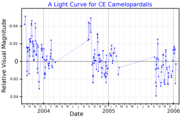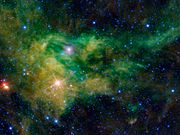
| |
| Observation data Epoch J2000 Equinox J2000 | |
|---|---|
| Constellation | Camelopardalis |
| Right ascension | 03 29 54.74360 |
| Declination | +58° 52′ 43.4969″ |
| Apparent magnitude (V) | 4.54 |
| Characteristics | |
| Evolutionary stage | Blue supergiant |
| Spectral type | A0 Iae |
| U−B color index | −0.11 |
| B−V color index | +0.56 |
| Variable type | α Cyg |
| Astrometry | |
| Radial velocity (Rv) | −6.20 km/s |
| Proper motion (μ) | RA: −2.247 mas/yr Dec.: −0.657 mas/yr |
| Parallax (π) | 0.9303 ± 0.1190 mas |
| Distance | approx. 3,500 ly (approx. 1,100 pc) |
| Absolute magnitude (MV) | −7.20 |
| Details | |
| Mass | 19.3 M☉ |
| Radius | 97 R☉ |
| Luminosity | 55,000 L☉ |
| Surface gravity (log g) | 1.75 cgs |
| Temperature | 9,730 K |
| Rotational velocity (v sin i) | 25 km/s |
| Age | 11 Myr |
| Other designations | |
| CE Camelopardalis, BD+58°607, HIP 16281, HR 1040, HD 21389, SAO 24061 | |
| Database references | |
| SIMBAD | data |
| Data sources: | |
| Hipparcos Catalogue, CCDM (2002), Bright Star Catalogue (5th rev. ed.) | |
HD 21389 is a supergiant variable star in reflection nebula VdB 15, in the constellation Camelopardalis. It has the variable star designation CE Camelopardalis, abbreviated CE Cam. It is a magnitude 4.5 star, and is visible to the naked eye. This object is part of the Camelopardalis OB1 association. The near-identical member CS Camelopardalis lies half a degree to the north.
Since 1943, the spectrum of CE Cam has served as one of the stable anchor points by which other stars are classified. In 1983, John R. Percy and Douglas L. Welch announced their discovery that HD 21389 is a variable star. It was given its variable star designation in 1997.
CE Camelopardalis is some 19 times as massive as the Sun and 55,000 times as luminous. Hohle and colleagues, using the parallax, extinction and analysis of spectrum, came up with a mass 14.95±0.41 times that and luminosity 62,679 times that of the Sun.
CE Cam is embedded in a large dusty molecular cloud, part of which it illuminates as a reflection nebula (vdB15 or BFS 29). This is a region of ongoing star formation with stars aged from one to a hundred million years old. CE Cam itself is thought to be around 11 million years old, long enough to have exhausted its core hydrogen and evolved away from the main sequence into a supergiant.
-
 A visual band light curve for CE Camelopardalis, adapted from Corliss et al. (2015)
A visual band light curve for CE Camelopardalis, adapted from Corliss et al. (2015)
-
 CE Cam and the surrounding nebulosity at infrared wavelengths (Credit: NASA/JPL-Caltech/UCLA)
CE Cam and the surrounding nebulosity at infrared wavelengths (Credit: NASA/JPL-Caltech/UCLA)
References
- ^ Vallenari, A.; et al. (Gaia collaboration) (2023). "Gaia Data Release 3. Summary of the content and survey properties". Astronomy and Astrophysics. 674: A1. arXiv:2208.00211. Bibcode:2023A&A...674A...1G. doi:10.1051/0004-6361/202243940. S2CID 244398875. Gaia DR3 record for this source at VizieR.
- ^ Shultz, M.; Wade, G. A.; Petit, V.; Grunhut, J.; Neiner, C.; Hanes, D.; MiMeS Collaboration (2014). "An observational evaluation of magnetic confinement in the winds of BA supergiants". Monthly Notices of the Royal Astronomical Society. 438 (2): 1114. arXiv:1311.5116. Bibcode:2014MNRAS.438.1114S. doi:10.1093/mnras/stt2260. S2CID 118557626.
- ^ Lyder, David A. (2001). "The Stars in Camelopardalis OB1: Their Distance and Evolutionary History". The Astronomical Journal. 122 (5): 2634–2643. Bibcode:2001AJ....122.2634L. doi:10.1086/323705.
- Samus, N. N.; Durlevich, O. V.; et al. (2009). "VizieR Online Data Catalog: General Catalogue of Variable Stars (Samus+ 2007-2013)". VizieR On-line Data Catalog: B/GCVS. Originally Published in: 2009yCat....102025S. 1. Bibcode:2009yCat....102025S.
- Gontcharov, G. A. (2006). "Pulkovo Compilation of Radial Velocities for 35 495 Hipparcos stars in a common system". Astronomy Letters. 32 (11): 759–771. arXiv:1606.08053. Bibcode:2006AstL...32..759G. doi:10.1134/S1063773706110065. S2CID 119231169.
- Garrison, R. F. (December 1993), "Anchor Points for the MK System of Spectral Classification", Bulletin of the American Astronomical Society, 25: 1319, Bibcode:1993AAS...183.1710G, archived from the original on 2019-06-25, retrieved 2012-02-04
- Percy, J. R.; Welch, D. L. (August 1983). "Photometric variability of B- and A-type supergiants". Publications of the Astronomical Society of the Pacific. 95: 491–505. Bibcode:1983PASP...95..491P. doi:10.1086/131198. Retrieved 29 December 2024.
- Kazarovets, E. V.; Samus, N. N. (April 1997). "The 73rd Name-List of Variable Stars" (PDF). Information Bulletin on Variable Stars. 4471: 1. Bibcode:1997IBVS.4471....1K. Retrieved 29 December 2024.
- Hohle, M. M.; Neuhäuser, R.; Schutz, B. F. (April 2010), "Masses and luminosities of O- and B-type stars and red supergiants", Astronomische Nachrichten, 331 (4): 349, arXiv:1003.2335, Bibcode:2010AN....331..349H, doi:10.1002/asna.200911355, S2CID 111387483
- Corliss, David J.; Morrison, Nancy D.; Adelman, Saul J. (December 2015). "Spectroscopic and Photometric Variability in the A0 Supergiant HR 1040". The Astronomical Journal. 150 (6): 190. Bibcode:2015AJ....150..190C. doi:10.1088/0004-6256/150/6/190. S2CID 126051683.
External links
| Constellation of Camelopardalis | |||||||||||||
|---|---|---|---|---|---|---|---|---|---|---|---|---|---|
| Stars |
| ||||||||||||
| |||||||||||||
| |||||||||||||
| |||||||||||||
| Galaxies |
| ||||||||||||
| |||||||||||||
| |||||||||||||